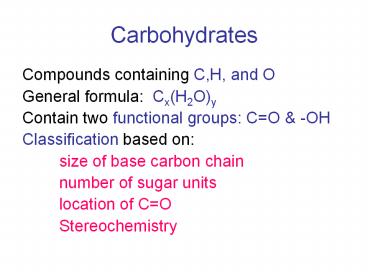Carbohydrates - PowerPoint PPT Presentation
1 / 19
Title:
Carbohydrates
Description:
... give an aldehyde group on carbon 1; this process is called keto-enol tautomerism. Under basic conditions fructose changes to an aldehyde by keto-enol tautomerism ... – PowerPoint PPT presentation
Number of Views:624
Avg rating:3.0/5.0
Title: Carbohydrates
1
Carbohydrates
- Compounds containing C,H, and O
- General formula Cx(H2O)y
- Contain two functional groups CO -OH
- Classification based on
- size of base carbon chain
- number of sugar units
- location of CO
- Stereochemistry
2
Types of Carbohydrates
- Classification based on the number of sugar units
in total chain - Monosaccharides single sugar unit
- Disaccharides two sugar units
- Oligosaccharides 3 to 10 sugar units
- Polysaccarides more than 10 units
- Chaining is done through bridging oxygen atoms
which are called glycoside bonds or glycosidic
bonds
3
Types of Carbohydrates
- Based on location of CO
- Monosaccharides with six carbons (hexoses) They
cannot be hydrolyzed into smaller units, unlike
disaccharides and polysaccharides. - Aldoses (aldehyde group)
- Ketoses (ketone group)
- C6H12O6 Glucose aldehyde group (blood
- sugar, grape sugar or
dextrose) - Galactose aldehyde group
- Fructose ketone group
4
Types of Carbohydrates
- Based on the number of carbons in the chain
triose, tetrose, pentose, hexose, etc
5
Types of Carbohydrates
- Disaccharides 2 monosaccharides from an a or ß
1,4- glycosidic bond with the loss of water. - Maltose (glucose glucose)(germinating grains)
- Lactose (glucose galactose)(milk, yogurt, ice
cream) - Sucrose ( glucose fructose) (table sugar,it is
found in sugar cane, sugar beets)
6
Types of Carbohydrates
- Polysaccharides long-chain polymers
- Starch rice, wheat, beans, potatoes and cereals.
- Amylose 20 of starch
- a-D-glucose molecules connected by
a1,4-glycosidic bonds in a continuous (straight)
chain. - 250-4000 glucose units
- Amylopectin 80 of starch
- a-1,4-glycosidic bonds connect most of the
glucose molecules - Every 25 glucose units there are branches of
glucose attached by a-1,6-glycosidic bonds
between carbon 1 of the branch and carbon 6 in
the main chain. - Glycogen is found in liver and muscle and is made
up - of glucose units. a-1,4-glycosidic bonds and
a-1,6- - glycosidic bonds
7
Types of Carbohydrates
- Polysaccharides long-chain polymers
- Cellulose wood and plants
- ß-1,4-glycosidic bonds connect the glucose
molecules to form unbranched chains that align in
parallel rows held in place by hydrogen bonds
which makes it more resistant to hydrolysis.
8
Stereochemistry and Stereoisomers
- Stereochemistry
- Study of the spatial arrangement of the molecules
- Stereoisomers
- Different spatial arrangements
- Different properties
- Same order and types of bonds
- Enantiomers
- They are mirror images of each other but they
cannot be overlapped - Designated by D- or L- at the start of the name
9
Stereoisomers enantiomers
- Chiral carbon (asymmetric carbon)
- a carbon that has 4 different groups
attached to it - You must have at least one asymmetric (chiral)
carbon in order to have stereoisomers
10
Physical Properties
- Optical activity
- ability to rotate plane polarized light
- Dextrorotatory
- Rotate to the right
- Usually D isomers
- Use symbol
- Levorotatory
- Rotate to the left
- Usually L isomers
- Use - symbol
11
D-Sugars
- All monosaccharides have more than one chiral
carbon, they are classified as - D-sugars if the chiral carbon furthest away
from the carbonyl group has the same
configuration as D-glyceraldehyde. If they are
dextrorotatory this is shown by a () after the
D if laevorotatory by - a (-).
12
Fischer Projections
- A tetrahedral carbon represented by two crossed
lines - A horizontal bond to an asymmetric (chiral)
carbon designates bonds in the front plane of the
page - Vertical bonds are behind the plane of the page
- Places the most oxidized group at the top
13
Important Monosaccharides
14
Intramolecular Cyclization
- In glucose the OH on carbon 5 forms a hemiacetal
bond with the aldehyde group. The new OH group on
carbon 1 may be drawn below carbon 1 ---- a form - above carbon 1-----ß form
- Haworth projections can be used to help see the a
and ß orientations
15
Haworth Structures
- ß a
- Change in rotation of solution is called
mutarotation. - The two forms are called anomers and the switch
is called epimerization. The cyclic structures
are hemiacetals.
16
Haworth Structures
ß-()-ribose D-()-galactose
a-D-(-)-fructose
17
Reducing Sugars
- Monosaccharides and most of disaccharides are
hemiacetals so they can be oxidized to carboxylic
acids, so they are reducing sugarsglucose,
galactose, fructose - Cu2 from the Benedict reagent is getting reduced
to Cu(Cu2O a green to red precipitate), so it is
the oxidizing agent - They react with alcohols at C1 forming an ether
linkage known as a glycosidic bond to form
disaccharides.
18
Reducing Sugars
- Ketoses are also reducing sugars, because the
ketone group on carbon 2 isomerizes to give an
aldehyde group on carbon 1 this process is
called keto-enol tautomerism - Under basic conditions fructose changes to an
aldehyde by keto-enol tautomerism - Polysaccharides are NOT reducing agents.
19
Disaccharides
Cellobiose ß(1-4)
maltose a(1-4)
Lactose ß(1-4) sucrose ß(1-2) Sucrose has both
sugars as acetals, no Benedicts reaction is not a
reducing sugar.































